Damselfly nymphs (order Odonata, suborder Zygoptera)

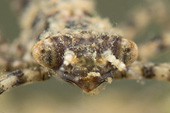
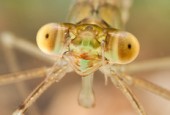
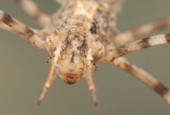
Contained families:
Coenagrionidae (Narrow-winged damselflies)
Platycnemididae (White-legged damselflies)
Lestidae (Spread-winged damselflies)
Calopterygidae (Broad-winged damselflies)
![]()
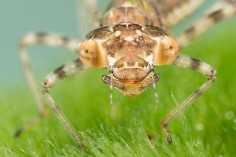
Narrow-winged damselfly nymphs
(order Odonata, suborder Zygoptera, family Coenagrionidae)
Feeding:
All damselfly nymphs are predators. Coenagrionid nymphs use sit and wait hunting strategy or actively stalk their prey.
Habitat:
Nymphs can be found in large variety of freshwater ecosystems.
Movement:
They mostly climb around aquatic vegetation and submerged wood.
Size:
Size of the mature nymphs varies among the species from 15 mm to about 30 mm (not including caudal gills).
Life cycle:
Damselflies undergo incomplete metamorphosis. Their life cycle includes three stages – egg, nymph and adult. Most species produce one generation per year. Some can have even two generations in one year.
Introduction:
Coenagrionidae is the most diverse and abundant family of damselflies. Nymphs live in wide range of freshwater ecosystems. They can be found in small ponds and streams, as well as in large lakes and rivers. The most common they are in still or slow flowing waters, where climb on aquatic plants or submerged pieces of terrestrial vegetation. Species, preferring running waters, hold firmly on the stones or any other solid surface. However, all damselfly nymphs can swim by side to side movements of their long body.
Damselfly nymphs are more slender than dragonfly nymphs. Their abdomen terminates in three caudal gills. Leaves resembling gills, with highly branched small veins, are held vertically and all three are about the same length. These fragile structures are sometimes broken off or lost when escaping the predators. The head is wider than thorax and the abdomen (in contrast to the majority of dragonfly nymphs). All antennal segments are about the same length.
Damselfly nymphs range in colour from black, brown, green and yellow. In combination with body shape and mottled patterns are very well camouflaged. Moreover, some of the less active species are covered with algae and a layer of sediments. In some cases, green or brown nymphs of the same species can be found in the same habitat, depending on the part where they live (among the plants by the surface or sediments at the bottom).
Prementum (middle section of the lower lip bearing labial palps) is triangular. Labial palps possess raptorial setae and terminate in sharp hooks. Nymphs feed on zooplankton and every smaller vanquishable invertebrates they come upon. Cannibalism among the species is no exception. Coenagrionid nymphs slowly stalk their prey among the vegetation. Nymphs, living in fast flowing waters, move reluctantly and just wait until current brings some prey into their reach.
Gallery:
Large red damselfly (Pyrrhosoma nymphula) emerging sequence:

White-legged damselfly nymphs
(order Odonata, suborder Zygoptera, family Platycnemididae)
Nymphs of the family Platycnemididae are usually dark in colour and prefer running water habitats. They have a distinctive shape of caudal gills that terminate with a thin filament at the tip of each lamella. Each lamella is lined with short to long marginal hairs.
White-legged damselflies (Platycnemididae) are closely related to Narrow-winged damselflies (Coenagrionidae), which are described above. The nymphs share almost all of their characteristics.
Gallery:
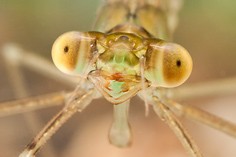
Spread-winged damselfly nymphs
(order Odonata, suborder Zygoptera, family Lestidae)
Feeding:
All damselfly nymphs are predators. Lestid nymphs use sit and wait hunting strategy or actively stalk their prey.
Habitat:
Nymphs live in still waters of ponds and lakes.
Movement:
They mostly climb around aquatic vegetation and submerged wood.
Size:
Mature nymphs can grow up to sizes around 40 mm (not including gills).
Life cycle:
Damselflies undergo incomplete metamorphosis. Their life cycle includes three stages – egg, nymph and adult. Most species require 1 or 2 years for one generation.
Introduction:
Damselfly nymphs of family Lestidae have very slender and elongated bodies. They range in colour from green to brown, often supplemented with mottled patterns. Legs are long and end with two claws. They are well camouflaged in stems or tangles of aquatic vegetation.
Nymphs have three long feather-like gills with small veins in perpendicular position to the larger vein in the middle. By waving the gills, nymphs create the circulation of water around the body and increase the amount of acquired oxygen. Moreover, nymphs can move surprisingly swiftly by wiggling side to side their long abdomens equipped with lamellated gills.
Long prementum (middle section of the lower lip bearing labial palps) is greatly narrowed. Labial palps terminate in sharp thorns and one movable hook, thereby forming a scoop. Large eyes and a long extendable mask enable the nymph to catch small and fast moving animals. Lestid nymphs feed on zooplankton, midge larvae, mosquito larvae and other small invertebrates. When the prey is grabbed, it is enclosed within the „basket“ of setae and interlocking teeth, tightened back, and subsequently crushed by chewing mouthparts.
Nymphs do not feed for several days before emergence and stay in vegetation by the surface.
Female damselflies lay eggs in plant tissue. Some species land by the surface and immerse just the tip of the abdomen, while others climb down the plant stems and totally submerge. If the male is holding the female to protect her from other males, both animals will submerge. On the way back, female just let go the stem and thin layer of air on the wings will raise them to the surface.
When ensuring the continuity of the future generations, many of them perish by drowning or are eaten by fish.
Gallery:
Spread-winged damselfly (Lestes sponsa) emerging sequence:
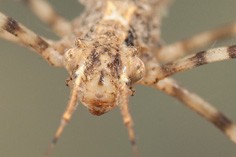 Broad-winged damselfly nymphs
Broad-winged damselfly nymphs
(order Odonata, suborder Zygoptera, family Calopterygidae)
Feeding:
All damselfly nymphs are predators. Calopterygid nymphs wait until the prey comes into their reach.
Habitat:
Nymphs live in flowing waters of streams and rivers.
Movement:
They mostly hold on roots or slowly climb on overhanging vegetation.
Size:
Mature nymphs can grow up to sizes around 40 mm (not including gills).
Life cycle:
Damselflies undergo incomplete metamorphosis. Their life cycle includes three stages – egg, nymph and adult. Most species require 1 or 2 years for one generation.
Introduction:
Nymphs of the family Calopterygidae need flowing and well-oxygenated water for living and development. They occur in parts of rivers and streams, where the current is moderate. Calopterygid nymphs are bad swimmers and can be washed away, when get to the stronger current (which makes them vulnerable to predators).
They are mostly found climbing on overhanging vegetation or among the root masses. Precisely roots of terrestrial vegetation, extending in tangles into the water, provide the best foothold and cover.
Calopterygid nymphs, with very slender and elongated bodies, mostly occur in shades of brown. Legs are long, thin and end with two claws. They move very slowly and do not often change their position in a habitat (therefore are covered with a layer of sediments). Lack of movement, colour and body shape make them perfectly camouflaged in accumulations of roots and twigs.
Long antennae are bent to the sides. The first antennal segment (closest to the head) is longer than the length of all subsequent segments.
Caudal gills, without visible veins, are triangular in cross section. Gill in the middle is slightly shorter than the side gills.
Extendable labium, with large cleft in the middle, is narrowed and lacks the setae. Labial palps terminate in sharp thorns and one movable hook. Nymphs feed on worm-like larvae, black fly larvae and other small invertebrates inhabiting flowing waters.
Iridescent green or blue adults are commonly observed around shaded woodland streams.
Gallery:



































































































